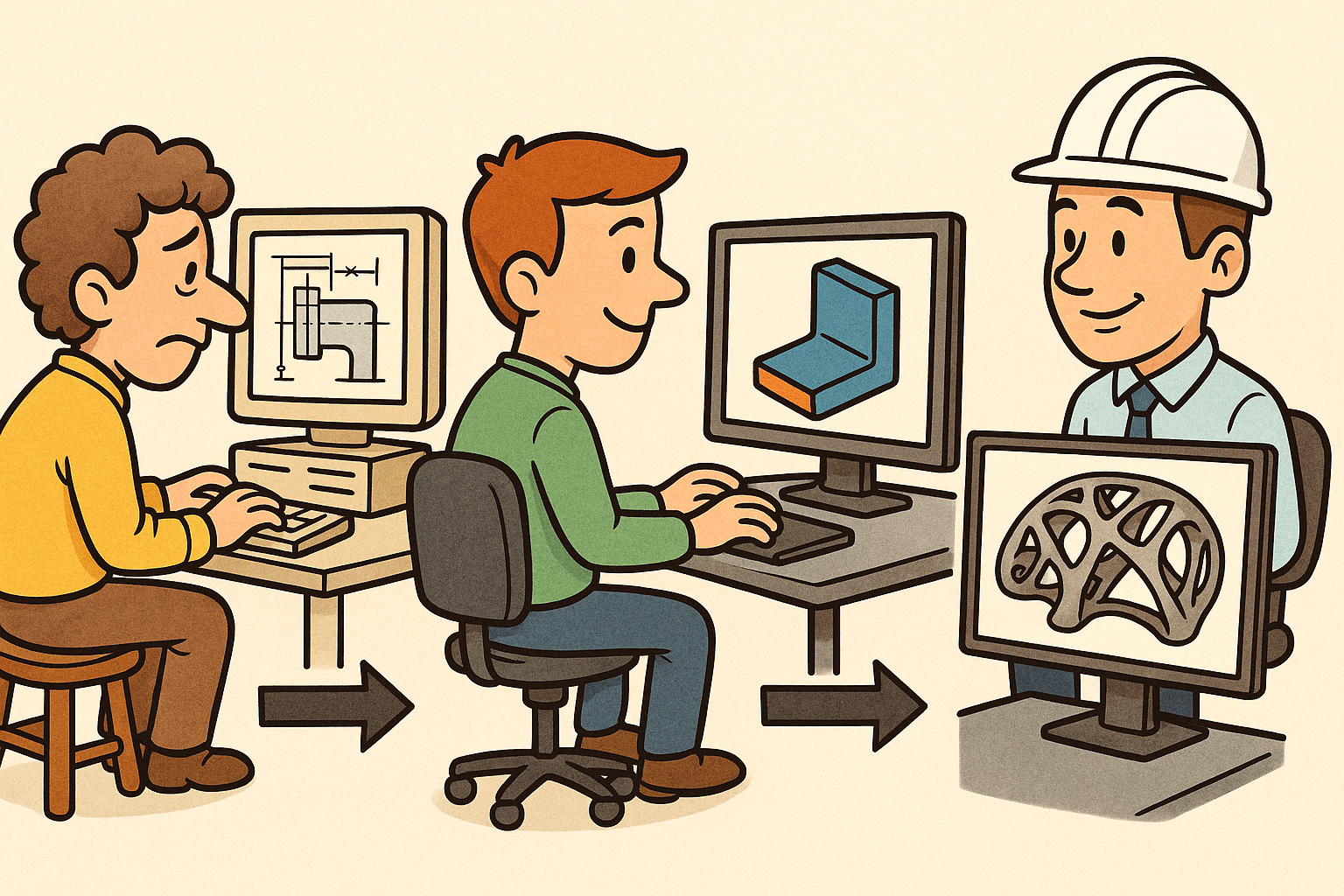Your Cart is Empty
Customer Testimonials
-
"Great customer service. The folks at Novedge were super helpful in navigating a somewhat complicated order including software upgrades and serial numbers in various stages of inactivity. They were friendly and helpful throughout the process.."
Ruben Ruckmark
"Quick & very helpful. We have been using Novedge for years and are very happy with their quick service when we need to make a purchase and excellent support resolving any issues."
Will Woodson
"Scott is the best. He reminds me about subscriptions dates, guides me in the correct direction for updates. He always responds promptly to me. He is literally the reason I continue to work with Novedge and will do so in the future."
Edward Mchugh
"Calvin Lok is “the man”. After my purchase of Sketchup 2021, he called me and provided step-by-step instructions to ease me through difficulties I was having with the setup of my new software."
Mike Borzage
Design Software History: Historical Evolution of Design Software: From Parametric to Non-Parametric Modeling and the Impact on Modern Engineering Practices
August 12, 2025 11 min read


Historical Definitions and Early Challenges
The evolution of computer-aided design began with the introduction of both parametric modeling and non-parametric modeling techniques that helped engineers and designers transition from manual drafting to automated design systems. Parametric modeling refers to the design approach where objects are defined by parameters and relational constraints, allowing designers to revise key dimensions and features in a controlled manner. In contrast, non-parametric modeling relies on static geometric definitions without implicit relationships among elements and is often linked with traditional drafting techniques extended into the digital realm. This foundational dichotomy established an early framework for design evolution as early computer-aided design (CAD) systems emerged. In the earliest CAD systems, limitations were apparent due to restricted computing power, rudimentary graphical interfaces, and minimal storage capabilities. These systems allowed engineers to create simple 2D designs, often requiring laborious manual adjustments to reflect design modifications. Designers and institutions had to learn to compromise between design flexibility and computational constraints, leading to a period during which the interplay between human expertise and emerging digital algorithms was essential in overcoming these initial limitations.
Defining the Core Concepts
A deeper understanding of both terminologies indicates that parametric modeling fosters a dynamic approach where changes to one aspect, for example a reference dimension, automatically adjust related features, streamlining the design iteration process. Meanwhile, non-parametric modeling offers a more static approach with potentially greater control over individual details, albeit with more manual intervention when design parameters change. Early engineers also rapidly discovered that the inherent limitations of primitive graphical interfaces forced them to adopt creative workarounds to represent complex objects accurately. The major CAD innovations of the time were heavily influenced by the available computational algorithms that underpinned these models, relying on basic geometric computations based on Euclidean geometry. These early systems, though limited, laid the groundwork for the continuing evolution of both parametric and non-parametric systems. Moreover, academic and industry research at the time stressed the need for computational efficiency with minimal hardware resources, further refining the basic algorithms required for transforming user input into geometric representations.
Computational Algorithms and Mathematical Foundations
At the core of these early design systems were mathematical principles – such as algebraic equations and algorithmic routines – that established the interplay between numeric inputs and precise geometric outputs. The mathematical foundations of CAD were primarily driven by the use of basic calculus, linear algebra, and numerical methods to translate abstract dimensions into tangible shapes and figures. These algorithms provided the means to solve a series of geometric constraints and over time became more sophisticated with the integration of advanced computations like Boolean operations in solid modeling systems. Many early researchers and developers sought to exploit these mathematical concepts to bring about a degree of automation to the design process. Their work in refining and adapting these algorithms laid the foundation for modern parametric design tools, which have since evolved into fully interactive systems able to update designs in real-time as parameter values change. Bulleted insights from this historical phase include:
- Dependence on algebraic and geometric methods to represent design constraints
- Emergence of basic Boolean operations for solid modeling
- Initial computing hardware limitations that influenced algorithm efficiency
- The gradual adoption of iterative methods for refining design outputs
This period in CAD history was marked by rapid innovation in the theoretical computation models that would later define both parametric and non-parametric methodologies for design software. The early advances in algorithmic strategies not only facilitated the transition from manual drafting to computer-aided design but also introduced a new way of defining and manipulating digital objects through parameter-based relationships, thereby making designs more responsive to changes. It was within this innovative milieu that the predominant design paradigms evolved, setting the stage for significant industry transformations in the decades to follow.
Origins and Pioneers in Parametric Modeling
The transition towards parametric modeling was largely driven by a desire among early design pioneers to overcome the static nature of non-parametric systems. Visionary companies such as PTC and Dassault Systèmes boldly altered the design landscape by incorporating powerful computational methods that enabled the automatic update of design features as parameters were modified. This innovative approach provided a significant leap forward in design efficiency, allowing engineers to experiment with different design alternatives without the burden of recreating components manually for each variation. PTC’s revolutionary software, which later evolved into Pro/ENGINEER, laid an important foundation for multidimensional parametric design by consolidating design constraints into easily modifiable parameters. Meanwhile, Dassault Systèmes elevated the competitive landscape with advanced systems like CATIA, which integrated complex assemblies and large-scale design management strategies seamlessly. These pioneering efforts allowed design engineers to harness the power of parametric constraints for rapid prototyping and iterative development, which proved especially valuable within the automotive and aerospace sectors.
Early Milestones in Parametric Innovation
From the inception of these tools, the parametric approach was designed to reduce design errors by automatically propagating changes across all related design elements. Major developments included the implementation of associative modeling, which ensured that any modifications to an element’s parameters would trigger a cascade of updates throughout the entire design. Additionally, enhanced computational algorithms greatly improved the efficiency of these systems, enabling designers to perform more sophisticated simulations and validations in real-time. The innovative algebraic solvers and constraint managers of the mid-to-late 1980s played a pivotal role in elevating parametric design as a standard practice. Key aspects of this evolutionary phase included:
- Introduction of automatic updates and self-referential modeling features
- The incorporation of robust constraint management systems
- Deployment of powerful algebraic and numerical solvers
- Broad adoption in industries where rapid design evolution was critical
Throughout this dynamic evolution, parametric modeling redefined the boundaries of design flexibility by shifting the design process from static representations to models imbued with intelligence and reactiveness. The pioneering efforts of companies such as PTC and Dassault Systèmes led to further technological advancements, eventually influencing the development of integrated product lifecycle management (PLM) systems that manage design data throughout the entire product lifecycle. In essence, the rise of parametric modeling was not just a technological breakthrough but also a paradigm shift that transformed fundamental design methodologies, offering designers unprecedented control over intricate details and complex assemblies, while paving the way for future innovations in design software development.
Benefits of Parametric Modeling in Modern Design
The shift to parametric design introduced several significant benefits that continue to shape engineering practices today. One of the most crucial advantages is the creation of flexible design systems where changes in one dimension or parameter automatically adjust the entire design, thus saving time and reducing human error. This approach has proven invaluable, particularly in environments that require extensive iterations and rapid prototyping. Furthermore, automated updates ensure that every aspect of an assembly remains consistent as modifications are introduced, fostering a higher degree of reliability in complex systems. By streamlining the process of design alterations, parametric modeling also supports the integration of automation in manufacturing, reducing overall production costs and improving product quality. Other benefits include:
- Enhanced design flexibility and ease of modification
- Significant reduction in revision time and potential for human error
- Support for complex assemblies through automated constraint propagation
- Improved synchronization between design components and manufacturing processes
As the design community moved to embrace parametric methodologies, the cumulative impact on the overall design and manufacturing process started to resonate across industries. The benefits were not only technological but also economic, as businesses were able to streamline operations and focus on innovation rather than reiteration. The improvements in design flexibility allowed companies to better meet the evolving needs of their customers by quickly adapting designs in response to market demands, thereby bolstering competitiveness and dynamic thinking. Overall, the historical evolution driven by pioneering innovators established a robust framework that would see parametric modeling become a fundamental technique in creating state-of-the-art design software solutions.
Alternative Approaches: The Rise of Non-Parametric Modeling
Despite the growing dominance of parametric modeling, early design engineers continued to rely on alternative methods that exemplified the principles of non-parametric modeling. These approaches had their roots in traditional drafting methods that evolved with the advent of computing technologies, providing an alternative strategy to manage complex design scenarios where full automation was either undesirable or impractical. Non-parametric systems adopted a more direct representation of design geometry, wherein the relationships between components were not automatically constrained. Instead, designers had direct control over the geometry of individual elements, thereby offering a level of precision that was sometimes necessary in specialized applications. In many instances, these systems were the preferred choice for tasks that benefited from manual intervention, where the designer’s expertise enabled them to introduce subtle variations that could not easily be automated. This hands-on approach was particularly prevalent in disciplines like architectural design and bespoke piece manufacturing, where constraints and creative flexibility were paramount.
Traditional Drafting Methods in a Digital World
The incorporation of non-parametric techniques into CAD software marked the seamless transition of age-old drafting practices into the digital era. Traditional tools such as computer-aided drafting (also known as CADD) were developed with the primary focus on replicating manual drawing techniques like line work, splines, and freeform curves in a digital environment. These tools provided a sense of continuity between the past and the future of design, ensuring that the well-honed skills of draftspersons were not rendered obsolete by purely algorithmic approaches. The design community appreciated the nuance offered by non-parametric methods, where changes required deliberate human intervention, thus preserving design intent in a way that fully automated parametric constraints often struggled to accomplish. Some of the hallmarks of traditional non-parametric CAD systems included:
- Direct manipulation of geometric shapes without imposed relational constraints
- Enhanced control for detailed manual adjustments
- Retention of traditional drafting methods adapted for digital interfaces
- Flexibility in scenarios where automated constraint propagation was not ideal
This methodological divergence ensured that while parametric systems gained popularity through their automated features, non-parametric approaches continued to serve specific niches by offering an alternative mode of design that placed greater emphasis on the designer’s intuition and manual control. The interplay between these two methodologies underscored the multifaceted nature of design software evolution, as each method came with its own set of advantages and limitations, ultimately complementing one another in diverse application environments. The early reliance on non-parametric techniques also informed later iterations of CAD software, encouraging the development of hybrid systems that could leverage the strengths of both paradigms.
Comparative Advantages and Application Areas
When comparing the benefits of non-parametric modeling with those of parametric design, it is clear that each approach offers distinct advantages depending on the application. Non-parametric modeling tends to shine in applications where precise manual control is necessary, such as in the initial conceptual phases of architectural design or artistic drafting. The lack of dependency on automated constraints means that designers can bypass the sometimes rigid frameworks imposed by parametric settings, allowing for more intuitive modifications. Conversely, in scenarios such as mass production, where design consistency and automated updates are crucial, parametric modeling holds a definitive edge. The contrasting strengths of these two methods have led to the formation of specialized toolkits within many modern design systems, where designers are given a choice depending on the task. Key application areas for non-parametric modeling include:
- Artistic and conceptual design projects
- Architectural renderings that require bespoke detailing
- Projects where manual refinement and intuition are critical
- Complex surface modeling in areas such as automotive styling
The historical distinction between these methodologies brings to light the broader challenge of effectively marrying automation with creative input. While parametric modeling offers impressive design benefits by automating many routine tasks, non-parametric systems remind us of the critical importance of human expertise and the bespoke nature of certain design processes. Designers and engineers often find that the decision to use one approach over the other hinges on the specific requirements of the project at hand, further emphasizing the dual legacy of CAD development. Overall, the evolution of non-parametric methods—from traditional drafting to sophisticated digital tools—has left an indelible mark on design software history and continues to influence modern hybrid design methodologies.
Comparative Analysis and Future Trends in Design Methodologies
In reviewing the historical evolution of design software, the debate between parametric and non-parametric modeling remains a topic of considerable interest among design professionals. Both methodologies possess strengths that have driven innovation in design software, each contributing uniquely to the way modern products and structures are conceived, tested, and manufactured. Parametric modeling has undoubtedly transformed the landscape of design by enabling dynamic updates and automating many revisions through mathematical and computational algorithms. These systems have provided robust frameworks for managing large assemblies and reducing design errors, making them especially popular in fields such as aerospace and automotive engineering. In contrast, the more flexible and controlled approach of non-parametric modeling continues to hold sway in specialized applications where creative freedom and nuanced adjustments are paramount. This comparative study reveals that while each method is rooted in distinct historical and philosophical contexts, their complementary features have collectively shaped the progression of design software.
Historical Impact on Software Innovation
The evolution of these design methodologies has been marked by significant contributions from leading software companies and pioneering engineers who recognized the need for flexibility, automation, and accuracy. Early innovations in constraint management and dynamic updating in parametric systems redefined the standards for automated design, while the direct, hands-on manipulation techniques inherent in non-parametric design kept traditional drafting skills relevant in a digital age. This duality fostered an environment ripe for hybridization, where software solutions began incorporating features from both paradigms. Designers could benefit from the precision of algorithm-driven updates without sacrificing the creative control offered by manual interventions. As a result, modern CAD systems often provide integrated toolsets that allow users to switch seamlessly between parametric and non-parametric methods according to project needs. Insights from this historical perspective highlight:
- The significant role of early software innovators in establishing contemporary design paradigms
- The mutually reinforcing effect of automated and manual design systems in fostering software evolution
- The critical importance of adaptable design frameworks that accommodate both methodologies
- The transition towards hybrid software solutions that offer the best of both worlds
Analyzing these developments, it becomes evident that the interplay between parametric and non-parametric approaches has not only diversified the toolset available to designers but has also continuously driven improvements in accuracy, efficiency, and overall creativity in design projects. While debates over the superiority of one method over the other persist in certain circles, the overall advancement in design software owes much to the integration of both philosophies, transforming the very nature of the creative process in engineering and architecture.
Future Trends and Convergence Possibilities
Looking ahead, the future of design software is poised to witness an unprecedented convergence of parameter-driven and manual manipulation techniques. Advances in artificial intelligence, machine learning, and real-time data integration promise to further blur the lines between parametric automation and non-parametric, free-form design. Emerging technologies are already beginning to offer tools that automatically adapt design parameters based on real-world feedback, while still permitting designers the freedom to override or fine-tune these algorithms manually. This synthesis is predicted to lead to a new generation of design software that not only accommodates both methodologies but leverages their combined strengths to produce more innovative, functional, and aesthetically pleasing designs. In this evolving landscape, the integration of high-level computational capabilities with user-centric design interfaces will create environments that encourage experimentation without compromising on precision. Future trends to watch include:
- Enhanced hybrid systems that merge real-time automated updates with flexible design controls
- The incorporation of AI-driven design assistants that provide tailored design recommendations
- Greater interoperability between product lifecycle management systems and design software
- Innovative user interfaces that streamline the process of switching between parametric and non-parametric modes
Such developments are indicative of an industry that is increasingly focused on breaking down the barriers between rigid computational modeling and the creative intuition of human designers. As these systems evolve, designers will likely find themselves with unprecedented levels of control and oversight, enabling them to harness the flexibility of non-parametric techniques alongside the powerful automation of parametric constraints. This convergence not only promises improvements in efficiency and accuracy, but also ensures that design software remains adaptable to the continually shifting demands of modern engineering and architectural practices. In conclusion, the journey of design software evolution—from rudimentary CAD systems to sophisticated, hybrid design environments—speaks to the enduring importance of both parametric and non-parametric methodologies. With ongoing innovations on the horizon, the future holds immense promise for a more integrated, holistic approach to design that leverages the best attributes of each paradigm.
Also in Design News

Cinema 4D Tip: Turbulence Field for Fast, Art‑Directable Organic Motion
December 27, 2025 2 min read
Read More
V-Ray Tip: Curvature and AO Masks for Realistic Material Wear
December 27, 2025 2 min read
Read MoreSubscribe
Sign up to get the latest on sales, new releases and more …



